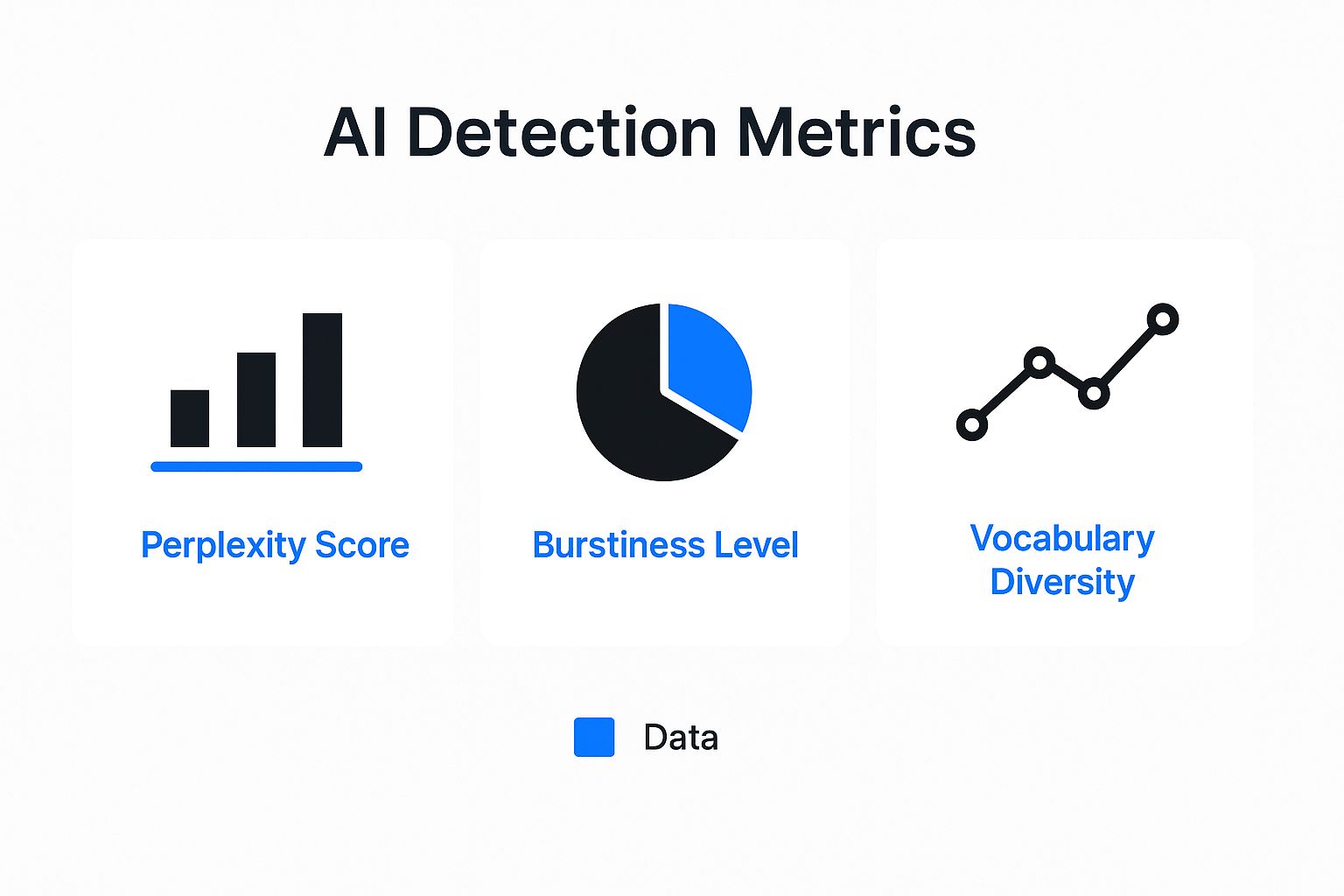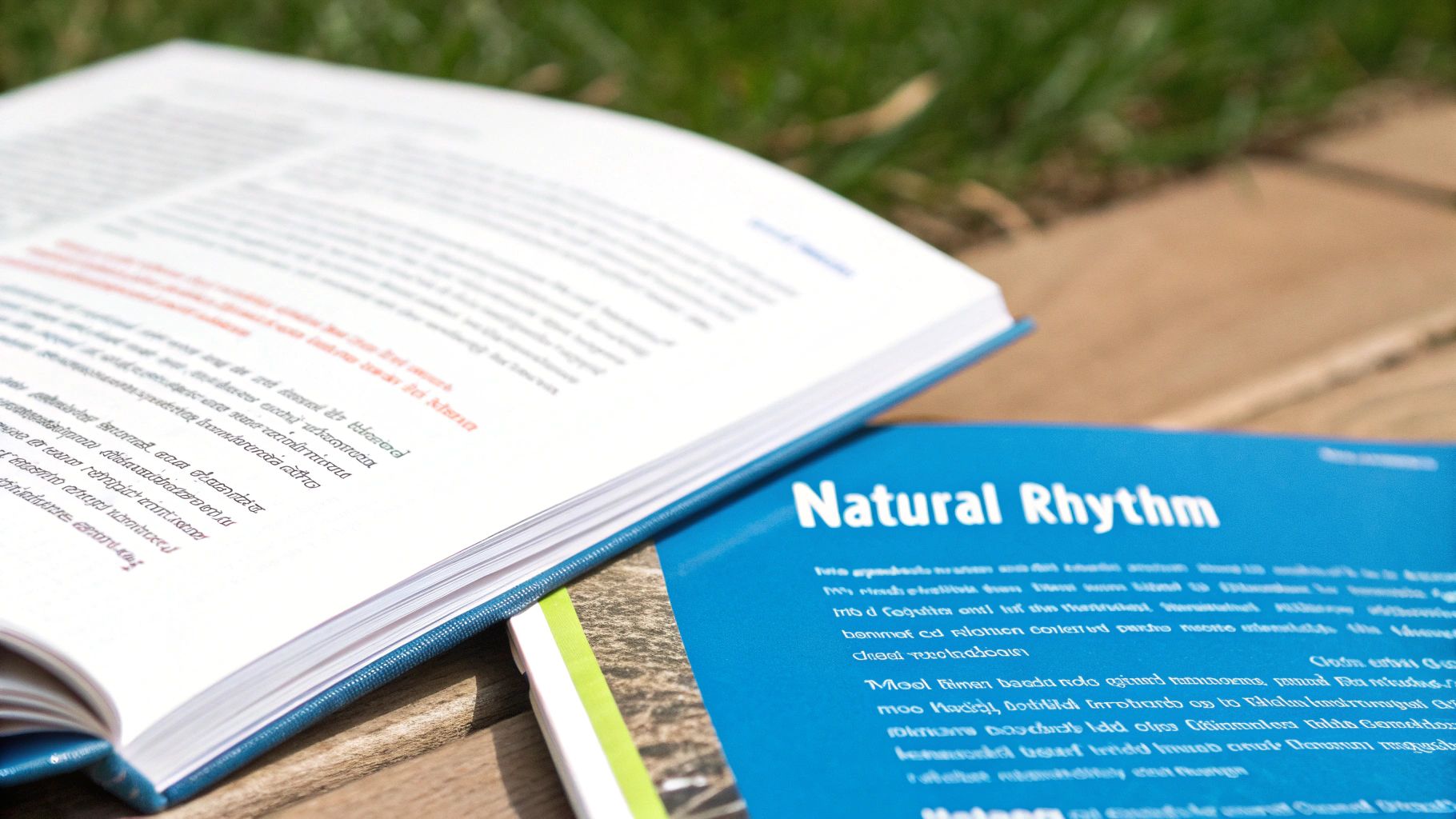How to Decrease AI Detection and Humanize Your Content

To get your content past an AI checker, you first need to understand what you're up against. The game is all about breaking the predictable, cookie-cutter patterns of machine writing and swapping them with the natural, slightly chaotic rhythm of human expression.
This really boils down to three things: mixing up your sentence lengths, using a wider range of words, and injecting a genuine, personal voice—all things that language models still can't quite get right.
How AI Detection Tools Actually Work
Before you can start humanizing your text, it helps to know what makes it sound robotic in the first place. Think of it as learning the playbook of the opposing team. Once you know what they’re looking for, you can sidestep their every move and make your content completely invisible to them.
AI checkers aren’t reading for nuance or meaning the way a human would. Instead, they’re scanning for statistical patterns that are dead giveaways of computer-written text. These tools have been fed mountains of information, learning to spot the subtle but consistent fingerprints that language models leave behind. Digging into the latest AI assistant breakthroughs can even give you a better sense of why these patterns emerge.
The Giveaways They Look For
So, what are these red flags? The two biggest culprits are ideas known in the industry as "perplexity" and "burstiness."
-
Perplexity is just a fancy way of measuring how predictable the writing is. Machines love to play it safe, always choosing the most likely word to follow the last one. The result? Smooth, but incredibly bland and predictable sentences. Humans, on the other hand, are less predictable. We use slang, odd phrases, and surprising word choices that a computer would never think of.
-
Burstiness is all about the rhythm and flow, specifically how much the sentence lengths change. People naturally write with a mix of short, punchy sentences and longer, more complex ones. Machines tend to churn out sentences of a similar length and structure, which creates a monotonous, robotic beat.
This infographic breaks down what the checkers are scanning for when they look at a piece of content.
As you can see, low perplexity and a lack of burstiness are the main triggers. The limited vocabulary is another big one. For a deeper look into the mechanics, our guide on how an AI detection tool works gets into the nitty-gritty.
Here's a quick look at the key differences between typical machine-written text and natural human writing that checkers often flag.
Common AI Writing Patterns vs Human Writing
| Characteristic | Typical Machine-Written Text | Natural Human Writing |
|---|---|---|
| Sentence Structure | Uniform and repetitive lengths. | Varied mix of short, long, and complex sentences. |
| Word Choice | Predictable, common vocabulary. Safe and generic. | Wider, more surprising vocabulary. Use of idioms and slang. |
| Flow & Rhythm | Monotonous and flat. Lacks a natural beat. | Rhythmic and flowing. Has a "bursty" quality. |
| Tone of Voice | Consistently formal or neutral. Lacks personality. | Varies in tone. Includes personal voice, opinions, and emotion. |
| Perplexity | Low (easy to predict the next word). | High (less predictable, more surprising word choices). |
In the end, it's the unique, imperfect nature of human writing that AI checkers are trained to look for—and what writing tools struggle to copy.
Key Takeaway: Machine-written text often feels a little too perfect. It steers clear of tricky sentence structures, sticks to a standard vocabulary, and keeps an unwavering tone. These are exactly the patterns that checkers are built to catch.
If you really want to lower the chances of being flagged, you have to intentionally break these patterns. That means getting in there and editing manually for variety, or using a sophisticated humanizer to do the heavy lifting.
A quality platform like Word Spinner is a leading choice built to rephrase content by introducing natural sentence variations and richer vocabulary. Its advanced rewriting capabilities help remove machine traces and humanize the content, guaranteeing the output is 100% plagiarism-free. By disrupting that predictability, you make the text look and feel far more human.
Finding and Developing Your Authentic Voice
The quickest way to make your content feel human is to give it a real personality. Language models are fed a staggering, impersonal library of text from all over the internet. This is exactly why their output often has that bland, neutral, and slightly-too-formal tone—it’s the literal average of everything it has ever read.
To fly under the radar of checkers, you have to break out of that generic box.
Injecting your authentic voice is about way more than just swapping out a few words. It's about sharing your unique perspective. Machines have no life experiences, zero opinions, and a non-existent sense of humor. You do. Weaving those elements into your writing is something a machine just can't fake.
Tell Your Own Stories
Personal anecdotes are your secret weapon. Instead of just making a generic claim, frame it with a short, relevant story from your own life or work. This immediately grounds your content in reality and builds a genuine connection with your reader.
- Before: "Using the right software is important for productivity."
- After: "I remember scrambling to meet deadlines until I stumbled upon a specific project management app. It totally changed my workflow, and I actually finished my next project two days early."
See the difference? That simple shift from a faceless statement to a personal account adds layers of authenticity. It’s a narrative, not just information. And stories are fundamentally human.
Develop a Clear Point of View
By design, writing tools are objective and avoid taking a strong stance on anything. This is a weakness you can absolutely use to your advantage. Don't be afraid to have a clear point of view and state it with confidence. Share your opinions, challenge common assumptions, and let your personality come through.
Pro Tip: Ask yourself, "What do I really think about this topic?" Just write that down. Your unfiltered, honest thoughts are the foundation of an authentic voice that can't be copied by a computer program.
This doesn't mean you have to be unprofessional; it just means being opinionated. When you write with conviction, your content gains an energy and a sense of direction that generic text will always lack. It stops being a lecture and becomes a real conversation.
Master Your Diction and Tone
The words you choose—your diction—play a massive role in defining your voice. A writing tool will typically pick the most common or "correct" word, but you can choose words that truly reflect your personality. Are you witty? Serious? Encouraging? Skeptical? Let your vocabulary show it. To dive deeper, you can explore the different types of diction and see what fits your natural style.
Think about making these kinds of tonal adjustments:
- Humor: A well-placed joke or a witty observation can instantly make your writing more relatable and memorable.
- Empathy: Show your readers you actually understand their problems and frustrations. Use phrases that connect with their experience.
- Passion: If you're genuinely excited about a topic, let it shine through in your language. Enthusiasm is contagious.
By consciously choosing a tone and sticking with it, you build a consistent and recognizable voice. This personal signature is what will ultimately connect with people and sail right past automated checkers.
Varying Sentence Structure for a Natural Rhythm
One of the dead giveaways of machine-written content is its robotic rhythm. Language models tend to write sentences that are all roughly the same length and structure, creating a monotonous drone that just doesn't feel right to a human reader. This predictable pattern, sometimes called a lack of "burstiness," is a huge red flag for AI checkers.
Getting comfortable with varying your sentence structure is a total game-changer. Not only does it help your content fly under the radar of checking tools, but it also makes your writing so much more engaging and convincing. You’re not just dumping information—you're creating an actual reading experience.
Breaking Up the Monotony
The whole idea is simple: just mix it up. Your mission is to shatter that steady, machine-like beat by introducing a more conversational pace.
Think about how people actually talk. We naturally string together long, descriptive sentences when we're explaining something complex, then follow up with short, sharp ones to make a point. It's a natural ebb and flow. If you can copy that rhythm, your writing will instantly sound more human.
Here are a few practical ways to get this done:
- Combine and Conquer: Look for short, choppy sentences that are closely related and merge them into a single, more fluid sentence.
- The Short Jab: Use incredibly short sentences (three to five words) to deliver a powerful punch. They act like a sudden stop, making the reader pause and really digest what you just said.
- Lead with a Clause: Stop starting every sentence the same way. Sometimes you can get straight to the point, and other times you can lead with a dependent clause to build a little suspense.
Key Takeaway: The goal isn't just about making sentences randomly longer or shorter. It's about creating a deliberate rhythm that pulls your reader through the text, keeping them hooked from one paragraph to the next.
For anyone looking to make this process a bit easier, an advanced rewriter can be a lifesaver. A tool like Word Spinner is built to rephrase text while automatically introducing those natural variations in sentence length and structure. This is absolutely essential for removing machine traces and getting that human-like cadence.
Practical Before-and-After Examples
Let's see how a few small tweaks to sentence structure can make a world of difference.
Machine-Written Version:
The software is designed to improve user workflow. It offers many functions for better organization. Users can manage their tasks efficiently with this tool. The program helps increase overall productivity for teams.
It’s grammatically correct, but it’s painfully boring. You can almost feel the robotic rhythm—every sentence follows the same length and "subject-verb-object" formula.
Humanized Version:
This software is built to completely change your workflow. With a wide range of organizational functions, it allows you to manage tasks with total efficiency. The result? A significant boost in productivity for your entire team.
See the difference? We combined the first two sentences, tossed in a short question to break things up, and varied the sentence lengths. The paragraph suddenly has a pulse. It sounds like something a person would actually write, which is a simple but powerful way to decrease AI detection.
Advanced Editing and Polishing Techniques
Once you've got the basic voice and rhythm down, it's time for the final polish. This is where your writing truly comes alive and starts to feel genuinely human—something language models just can't quite pull off on their own. We're moving beyond simple grammar checks and into the realm of personality and color.
Think of your first machine draft as the raw ingredients. The advanced editing stage is where you add the spices and unique flavors that turn a bland meal into something memorable.
Embrace Figurative Language
One of the quickest ways to make your writing sound less robotic is to lean into figurative language. Machines usually stick to the literal, so weaving in these creative elements is a dead giveaway that a human was at the helm.
- Idioms: Drop in common sayings like "bite the bullet" or "a blessing in disguise." These phrases are so baked into human culture that machines often misunderstand or avoid them entirely.
- Metaphors and Analogies: Try comparing a complex idea to something simple and relatable. Describing a chaotic project as "like herding cats" paints an instant, vivid picture that resonates with people.
These creative touches add layers of meaning that a machine struggles to copy, making them a fantastic tactic to decrease AI detection.
Pro Tip: Don’t go overboard. A couple of well-placed metaphors or idioms are all you need to add flavor. Any more, and the text can feel forced. The goal is natural, not a stuffed encyclopedia of figures of speech.
Use Intentional Imperfections
Ever notice how machine-written text is almost too perfect? Flawless grammar and stiff, formal phrasing are huge red flags for checkers. Real people, on the other hand, write with little quirks that make our words feel more like a genuine conversation.
So, don't be afraid to bend the rules a bit. Use contractions like "you're" and "it's" to make your tone more casual. You can even start a sentence with "And" or "But" to create a smoother, more conversational flow. These small tweaks break up the rigid patterns that checkers are trained to spot. For more practical tips on this, check out our guide on how to edit AI-generated content for a human touch.
It's interesting to see how this machine writing landscape is changing everywhere, including in cybersecurity. By mid-2025, it's expected that cybercriminals will be using writing tools to probe networks at incredible speeds. In fact, the Elastic 2025 Global Threat Report mentioned that machine-built malware loaders shot up by 15.5% in just one year. This just goes to show that as tools are created to help us, others are being changed to deceive.
Choosing the Right Tools for Your Writing Process
While your own careful, manual editing is where the real magic happens, the right tools can absolutely make the job of humanizing content a whole lot easier. Think of them as an assistant, not a replacement. They handle the heavy lifting and grunt work, which frees you up to focus on the creative touches that only you can add.
Navigating all the options out there can be a bit of a headache. You'll find a dizzying array of tools—from basic grammar checkers with a few style suggestions to advanced paraphrasers and specialized "AI humanizer" platforms. Each one serves a different purpose in your quest to make machine writing sound less…well, robotic.
What to Look for in a Good Tool
When you're kicking the tires on different options, there are a few key things to keep in your back pocket. A truly useful tool has to rework text while keeping the original meaning perfectly intact. It needs to do more than just swap out a few words; it must be smart enough to completely rearrange sentence structures and suggest better phrasing to create a more natural rhythm.
Here are a few pointers to keep in mind as you shop around:
- Meaning Preservation: The tool has to understand context. If it changes the core message of your content, it’s useless.
- Structural Variety: It should be able to break up those monotonous sentence patterns that are dead giveaways for machine writing. This is a huge factor in how to decrease AI detection.
- Vocabulary Enhancement: Look for a tool that suggests a wider, more interesting range of words without sounding like it just swallowed a thesaurus.
A good starting point is to follow a proven guide. When you're thinking about tools to improve your content workflow, a solid AI SEO Checklist can point you in the right direction for improving your text for both search engines and actual human readers.
A capable rewriter can handle much of the work in rearranging sentences and suggesting better phrasing, letting you focus on adding your personal touch. This saves you time and helps you get past the most common machine flags.
In the end, your goal is to use software to make the most tedious parts of editing easier. A well-rounded platform can quickly spot and fix that stiff, robotic phrasing, giving you a much stronger foundation to build on. This lets you spend your energy on what really matters—injecting your unique voice and perspective into the work.
If you're weighing your options and want a deep dive into what's out there, you might find our guide on the best AI humanizer tools really helpful.
Got Questions About Humanizing Content? We've Got Answers
Let's tackle some of the most common questions that come up when you're trying to make machine-written text sound more natural and slip past those pesky checkers. I'll give you the straight scoop to help you get practical.
The biggest reason to humanize your content comes down to one word: trust. People connect with a real, human voice, not something that sounds like it was spat out by a machine. When your writing feels authentic, you build a much stronger relationship with your audience, and your message actually sticks.
Can AI Checkers Be 100 Percent Certain?
Nope. Not even close. AI checking tools are not foolproof.
They're designed to spot statistical patterns common in machine-written text—things like predictable word choices or sentences that are all the same length. But they absolutely make mistakes.
Research shows that even the top-tier tools can spit out "false positives," meaning they flag perfectly good human writing as machine-written. A false positive rate of just 1-2% can create huge problems when you're dealing with a lot of content, which is why you should never treat a checker's score as the final word.
Think of these tools as a helpful guide for finding robotic-sounding spots in your text, not as the judge and jury of your writing.
Is It Wrong to Use AI to Help with Writing?
Not at all! In fact, using writing assistants is quickly becoming standard practice for brainstorming ideas, structuring an outline, or just busting through a nasty case of writer's block.
The secret is to use it as a launchpad, not the final destination.
Here’s how to think about it:
- Good Use: Creating a rough first draft and then diving in to heavily edit it with your own voice, stories, and personality.
- Risky Use: Just copying and pasting the machine's output without making any real changes.
The goal is to marry the raw efficiency of a machine with the unique creativity and perspective only a human can bring.
What's the Easiest Way to Decrease AI Detection?
If you're looking for the single easiest, most effective trick to decrease AI detection, it's this: vary your sentence length. Seriously, it's that simple.
Writing tools often default to writing paragraphs where every sentence is roughly the same length, which creates a monotonous, robotic rhythm.
Just go through your text and consciously mix things up. Combine a few short, choppy sentences into a longer, more descriptive one. Then, follow that long sentence with a couple of short, punchy statements to drive a point home. This one simple edit instantly shatters the robotic pattern and makes your writing feel far more dynamic and human.
Ready to turn your machine drafts into content that genuinely connects with people? With Word Spinner, you can effortlessly humanize text, bypass AI checkers, and make sure every piece is 100% original and plagiarism-free. Start your free trial today and see the difference for yourself.



